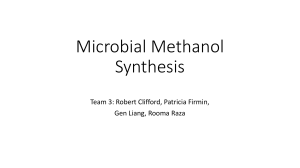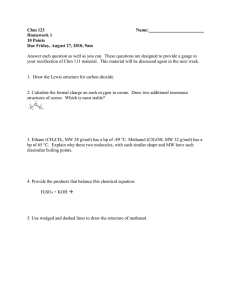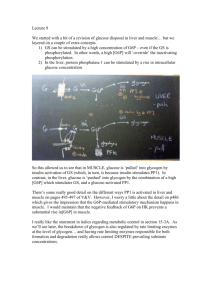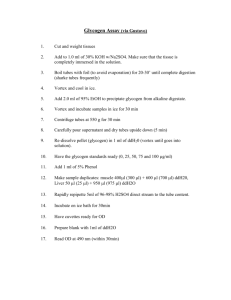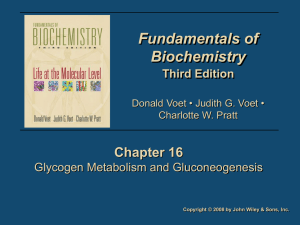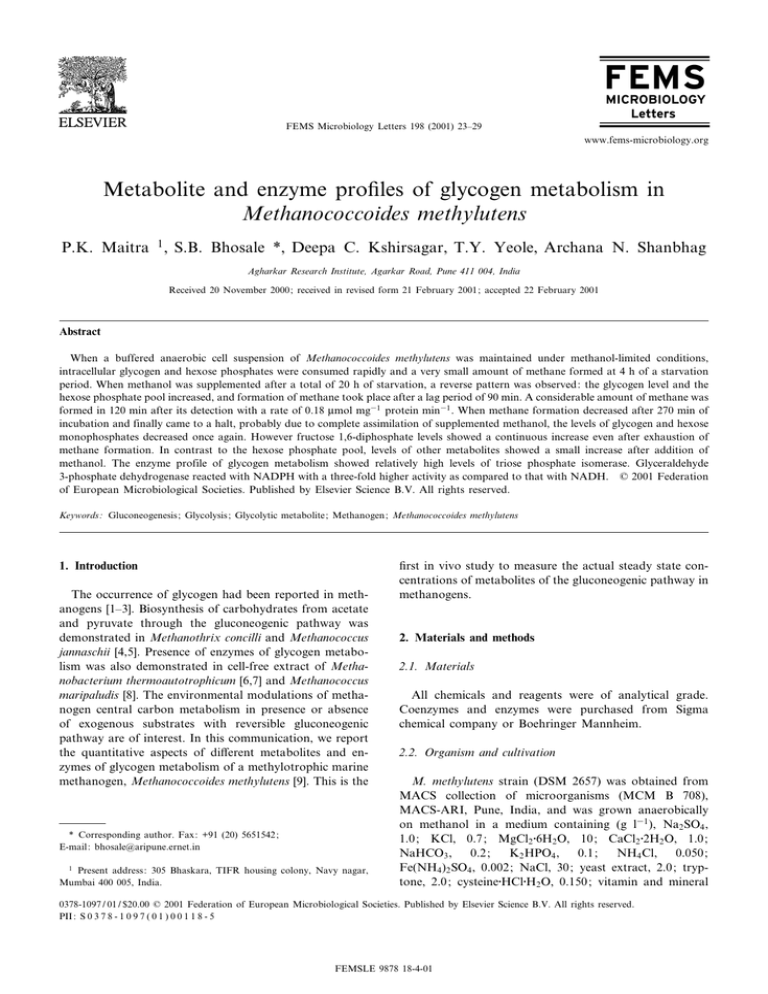
FEMS Microbiology Letters 198 (2001) 23^29
www.fems-microbiology.org
Metabolite and enzyme pro¢les of glycogen metabolism in
Methanococcoides methylutens
P.K. Maitra 1 , S.B. Bhosale *, Deepa C. Kshirsagar, T.Y. Yeole, Archana N. Shanbhag
Agharkar Research Institute, Agarkar Road, Pune 411 004, India
Received 20 November 2000 ; received in revised form 21 February 2001; accepted 22 February 2001
Abstract
When a buffered anaerobic cell suspension of Methanococcoides methylutens was maintained under methanol-limited conditions,
intracellular glycogen and hexose phosphates were consumed rapidly and a very small amount of methane formed at 4 h of a starvation
period. When methanol was supplemented after a total of 20 h of starvation, a reverse pattern was observed: the glycogen level and the
hexose phosphate pool increased, and formation of methane took place after a lag period of 90 min. A considerable amount of methane was
formed in 120 min after its detection with a rate of 0.18 Wmol mg31 protein min31 . When methane formation decreased after 270 min of
incubation and finally came to a halt, probably due to complete assimilation of supplemented methanol, the levels of glycogen and hexose
monophosphates decreased once again. However fructose 1,6-diphosphate levels showed a continuous increase even after exhaustion of
methane formation. In contrast to the hexose phosphate pool, levels of other metabolites showed a small increase after addition of
methanol. The enzyme profile of glycogen metabolism showed relatively high levels of triose phosphate isomerase. Glyceraldehyde
3-phosphate dehydrogenase reacted with NADPH with a three-fold higher activity as compared to that with NADH. ß 2001 Federation
of European Microbiological Societies. Published by Elsevier Science B.V. All rights reserved.
Keywords : Gluconeogenesis ; Glycolysis ; Glycolytic metabolite; Methanogen; Methanococcoides methylutens
1. Introduction
The occurrence of glycogen had been reported in methanogens [1^3]. Biosynthesis of carbohydrates from acetate
and pyruvate through the gluconeogenic pathway was
demonstrated in Methanothrix concilli and Methanococcus
jannaschii [4,5]. Presence of enzymes of glycogen metabolism was also demonstrated in cell-free extract of Methanobacterium thermoautotrophicum [6,7] and Methanococcus
maripaludis [8]. The environmental modulations of methanogen central carbon metabolism in presence or absence
of exogenous substrates with reversible gluconeogenic
pathway are of interest. In this communication, we report
the quantitative aspects of di¡erent metabolites and enzymes of glycogen metabolism of a methylotrophic marine
methanogen, Methanococcoides methylutens [9]. This is the
* Corresponding author. Fax: +91 (20) 5651542;
E-mail : bhosale@aripune.ernet.in
1
Present address: 305 Bhaskara, TIFR housing colony, Navy nagar,
Mumbai 400 005, India.
¢rst in vivo study to measure the actual steady state concentrations of metabolites of the gluconeogenic pathway in
methanogens.
2. Materials and methods
2.1. Materials
All chemicals and reagents were of analytical grade.
Coenzymes and enzymes were purchased from Sigma
chemical company or Boehringer Mannheim.
2.2. Organism and cultivation
M. methylutens strain (DSM 2657) was obtained from
MACS collection of microorganisms (MCM B 708),
MACS-ARI, Pune, India, and was grown anaerobically
on methanol in a medium containing (g l31 ), Na2 SO4 ,
1.0; KCl, 0.7; MgCl2 W6H2 O, 10; CaCl2 W2H2 O, 1.0;
K2 HPO4 , 0.1;
NH4 Cl, 0.050;
NaHCO3 , 0.2;
Fe(NH4 )2 SO4 , 0.002; NaCl, 30; yeast extract, 2.0; tryptone, 2.0; cysteineWHClWH2 O, 0.150; vitamin and mineral
0378-1097 / 01 / $20.00 ß 2001 Federation of European Microbiological Societies. Published by Elsevier Science B.V. All rights reserved.
PII: S 0 3 7 8 - 1 0 9 7 ( 0 1 ) 0 0 1 1 8 - 5
FEMSLE 9878 18-4-01
24
P.K. Maitra et al. / FEMS Microbiology Letters 198 (2001) 23^29
solution 10 ml each at pH 7.0 under an atmosphere of N2
as described by Balch et al. [10].
340 nm. Similarly glycogen content in the fraction containing cell wall was also measured.
2.3. Preparation of cell suspension
2.6. Extraction and determination of metabolites and
adenine nucleotides
All preparations were carried out at room temperature
under strictly anaerobic conditions in an atmosphere of
N2 . Cells were harvested at 48 h of active growth, washed
anaerobically and resuspended in an anaerobically maintained medium (above), modi¢ed as: NaCl content was
reduced to 10 g l31 and methanol, yeast extract, tryptone,
vitamins and minerals were deleted, giving a cell concentration of 6^7 mg protein per ml and was incubated at
37³C under N2 atmosphere. The cell suspension was incubated at 37³C under N2 atmosphere in methanol-limited
conditions for 20 h (31200 min) and at 0 min methanol
was supplemented to a concentration of 100 mM to develop methanol-su¤cient conditions.
Samples were taken out from the gas phase for determination of methane and carbon dioxide by a gas chromatograph equipped with a Porapak Q column and thermal conductivity detector. Hydrogen was used as a carrier
gas. The volume of gas other than head space was measured by displacement of water. The bottle was £ushed out
thoroughly at intervals and pressurized with N2 , after removal of the cell suspension for determination of glycogen
and metabolites.
The cell suspension described above was incubated at
37³C under nitrogen atmosphere. At appropriate time intervals, 2-ml samples were taken out with a syringe, before
and after addition of methanol to a concentration of 100
mM, and immediately added to 1 ml of ice-cold 15%
perchloric acid and mixed thoroughly. The samples were
kept on ice for 30 min and then centrifuged. The supernatant was brought to pH 7.0 by the addition of triethanolamine hydrochloride^KOH solution as described by
Maitra and Estabrook [12] and precipitated KClO4 was
removed by centrifugation. Supernatant was used for determination of di¡erent acid stable metabolites and adenine nucleotides [12,13]. Enzymic determinations of metabolites were performed at 37³C using 0.2 ml supernatant
in 0.8 ml 50 mM TRA-Mg-K bu¡er, pH 7.5, by coupling
appropriate enzymes with spectrophotometric detection of
NADH, NADPH or related metabolites. NADH and
NADPH levels have been raised to cope with the spectrophotometric method monitored at 340 nm. Pyruvate analysis was performed as earliest to avoid loss by polymerization. 1,3-Diphosphoglycerate was not determined as it
was unstable during the acid extraction. Standards were
run with known quantities of metabolites and adenine
nucleotides.
2.5. Extraction and determination of glycogen
2.7. Preparation of cell-free extracts and enzyme assays
Extraction and determination of glycogen were carried
out as described by Gunja-Smith et al. [11] with slight
modi¢cations. At appropriate time intervals, 1 ml cell suspension was removed, centrifuged, washed and resuspended in 0.5 ml of 20% KOH. Tubes were immersed in
a boiling water-bath for 1 h and after cooling, the suspensions were adjusted to pH 6^7 with 5 N HCl. The suspension was centrifuged at 5000 rpm for 10 min and washed
with water. The volume of supernatant and washings was
adjusted to 2 ml with water. The cell wall containing pellet
was also suspended in 2 ml of water with gentle warming.
For determination of glycogen, 0.2 ml of supernatant was
incubated at 37³C for 2 h in a reaction mixture containing
0.8 ml of 50 mM citrate bu¡er, pH 5, 5 mM calcium
chloride, 5 U of Aspergillus niger amyloglucosidase and
5 U of porcine pancreatic K-amylase. After complete digestion of glycogen, the liberated glucose was determined
from a 0.2-ml aliquot by enzymic reactions of yeast hexokinase (2 U) and yeast glucose 6-phosphate (G6P) dehydrogenase (5 U) in presence of 0.4 mM NADP in 0.8 ml
bu¡er containing 50 mM triethanolamine hydrochloride^
20 mM KCl and 10 mM MgCl2 (TRA-Mg-K bu¡er), pH
7.5. The reaction was monitored spectrophotometrically at
Washed cell pellet was suspended in 50 mM phosphate
bu¡er, pH 7.5, containing 5 mM dithiothreitol (DTT) and
immediately sonicated at 4³C. Cell debris was removed by
centrifugation at 38 000Ug for 20 min and the supernatant
served as the enzyme solution. Extracts were always used
on the same day of preparation. Enzymes were assayed by
coupling the particular step to the appropriate NAD - or
NADP -linked reaction, with the use of commercially
available crystalline enzymes as coupling enzymes. Enzyme assays can be referred to largely in Maitra and
Lobo [14] and also to Yu et al. [8]. The rate of production
or disappearance of reduced nucleotides was followed continuously on a Shimadzu double beam spectrophotometer
UV-2501 PC. Protein was determined by the biuret method [15]. One milliunit (mU) of enzyme activity is de¢ned
as 1 nmol of product formed per min and speci¢c activities
are presented in mU per mg of protein.
In most of the cases cell-free extract was diluted for
enzyme assays in cold 50 mM phosphate bu¡er, pH 7.5,
containing 2 mM EDTA and 2 mM L-mercaptoethanol.
Addition of EDTA was avoided in case of enolase and
aldolase. Assays of pyruvate kinase, phosphofructokinase
and NADH-glyceraldehyde 3-phosphate dehydrogenase
2.4. Analysis of gases
FEMSLE 9878 18-4-01
P.K. Maitra et al. / FEMS Microbiology Letters 198 (2001) 23^29
were carried out with undiluted cell-free extract. G6P isomerase was assayed by the fructose 6-phosphate (F6P)-dependent formation of G6P and the reaction was initiated
with 2 mM F6P that was freed from G6P. The produced
G6P was measured in presence of 0.4 mM NADP and
G6P dehydrogenase. 6-Phosphofructokinase was measured
by coupling to fructose 1,6-diphosphate (F1,6-diP) aldolase, triose phosphate isomerase and glycerol 3-phosphate
dehydrogenase. The enzyme assay was carried out in 50
mM phosphate bu¡er, pH 6, containing 0.25 mM NADH
and 1 mM ATP. The reaction was initiated with 5 mM
F6P. Fructose 1,6-diphosphatase was measured in presence of 0.4 mM NADP , 3 U of yeast G6P isomerase
and 2 U of yeast G6P dehydrogenase. The reaction was
initiated with 2 mM F1,6-diP [7]. F1,6-diP aldolase was
assayed in a catabolic direction in presence of 1 mM
NADH, 2 U of rabbit muscle glycerol 3-phosphate dehydrogenase, 10 U of rabbit muscle triose phosphate isomerase. The reaction was initiated with 2 mM F1,6-diP. Triose
phosphate isomerase was measured in an assay mixture
containing 0.4 mM NADH and 2 U of rabbit muscle
glycerol 3-phosphate dehydrogenase. The reaction was initiated with 2 mM glyceraldehyde 3-phosphate [7].
NADH- and NADPH-dependent activity of glyceraldehyde 3-phosphate dehydrogenase was measured by glyceraldehyde 3-phosphate dehydrogenase^phosphoglycerate
kinase coupled assay in presence of 20 mM cysteine, 0.4
mM NADH or NADPH, 50 mM ATP, 10 U of bakers
yeast phosphoglycerate kinase. The reaction was initiated
with 2 mM 3-phosphoglycerate. Phoshoglycerate kinase
was assayed in presence of 20 mM cysteine hydrochloride,
2 mM 3-phosphoglycerate, 0.25 mM NADH, 2 U of rabbit muscle glyceraldehyde 3-phosphate dehydrogenase.
The reaction was initiated with 2 mM ATP [6]. Phosphoglycerate mutase was assayed in a mixture containing 0.25
mM NADH, 2 mM ADP, 1 U of rabbit muscle enolase,
5 U of rabbit muscle lactate dehydrogenase, 2 U of rabbit
muscle pyruvate kinase. The reaction was initiated with
2 mM 3-phosphoglycerate. Enolase assay was done in
the same way as for phosphoglycerate mutase, 10 U of
rabbit muscle phosphoglycerate mutase substituting for
the crystalline enolase. Pyruvate kinase was measured in
presence of 50 mM phosphate bu¡er, pH 7.5, 2 mM
MnCl2 , 0.25 mM NADH, 20 mM DTT, 2 mM ADP,
2 U of rabbit muscle lactate dehydrogenase. The reaction
was initiated with 10 mM phosphoenol pyruvate.
25
was released by digestion of resuspended pellet containing
cell wall, obtained after cell breakage, with the above enzymes. Similarly glucose was not detected in glycogen-containing fractions unless amyloglucosidase and K-amylase
treatment was made. This rules out the presence of free
glucose in the cells.
When M. methylutens was grown under nitrogen-limiting conditions (50 mg NH4 Cl l31 ) for 48 h, glycogen accumulated in cells. Cells grown under nitrogen-limiting
conditions and suspended in methanol-limited conditions
showed a rapid decrease of the glycogen content in the
initial 240 min of incubation (Fig. 1). During the incubation period of 3^4 h (at 3960 min) in methanol-limited
conditions cells of M. methylutens produced methane and
CO2 , 6.4 and 0.1 nmol mg31 protein respectively (data not
presented in Fig. 1) following which the methane and carbon dioxide formation ceased. This indicates that methane
and carbon dioxide could be formed by M. methylutens
from intracellular glycogen as also from its other metabolites for a limited period of incubation in methanol-limited conditions. About 6.4 nmol of methane was produced,
in the early starvation period of 4 h, from 72 nmol of
glucose which indicates that about one carbon of glucose
is converted to methane. Konig et al. [2] also showed a
similar relationship of methane to glucose during glycogen
degradation with M. tindarius. Murray and Zinder [3] observed that within 21 h most of the glycogen was metabolized. However in case of M. methylutens it was observed
that about 50% glycogen was metabolized in 20 h of starvation period. After starvation of methanol for 20 h the
3. Results and discussion
3.1. Glycogen metabolism and methanogenesis in
M. methylutens
The glycogen content in extract was determined as glucose liberated after complete digestion of glycogen with
amyloglucosidase and K-amylase. No detectable glucose
Fig. 1. E¡ect of methanol on the glycogen metabolism and methanogenesis of M. methylutens. The cell suspension of 25 ml under N2 atmosphere had a protein content of 6^7 mg ml31 . At time zero methanol
was added to a ¢nal concentration of 100 mM. Glycogen was measured
as glucose liberated after amyloglucosidase and K-amylase treatment.
The data presented are the average of two separate experiments. Glycogen (E), methane (a) and carbon dioxide (O).
FEMSLE 9878 18-4-01
26
P.K. Maitra et al. / FEMS Microbiology Letters 198 (2001) 23^29
cell suspension was supplemented with methanol (¢nal
concentration 100 mM). In the initial 10 min, no methane
or CO2 was detected in gas phase, however, a decrease in
glycogen content was observed. After 30 min of incubation carbon dioxide (0.2 Wmol mg31 protein) was detected
in the gas phase and it increased continuously. Methane
formation was observed from 90 min of incubation period
and it was 0.3 Wmol mg31 protein. Then it steadily increased during the next 120 min to 20.28 Wmol mg31 protein with a rate of 0.18 Wmol mg31 protein min31 and then
decreased rapidly (Fig. 1) possibly due to exhaustion of
exogenous methanol as 20.28 Wmol of methane produced
requires about 27 Wmol of methanol. About 24 Wmol of
methane and and 5 Wmol of CO2 were produced after
supplementation of methanol which required about 32
Wmol of methanol. Thus the methane and CO2 were obtained from exogenous methanol. The exogenous methanol also appeared to be converted to glycogen. After 60
min of incubation with methanol the glycogen content
increased gradually yielding about 38 nmol mg31 protein
in the next 150 min of incubation in methanol-su¤cient
conditions indicating biosynthesis of glycogen. The observed rate of glycogen synthesis was about 0.25 nmol
mg31 protein min31 . The glycogen content reached a maximum at 210 min of incubation and then again showed a
decreasing trend indicating its assimilation by the cells due
to exhaustion of exogenous methanol due to formation of
a considerable amount of methane at 210 min incubation
period. This showed that there is a de¢nite metabolic process in M. methylutens to utilize and biosynthesize glycogen which functions depending upon the availability of
exogenous substrate.
3.2. Steady state levels of glycolytic intermediates
The procedure employed has been used to regulate, in
vivo, formation of metabolites in methanol-limited (starvation of substrate), methanol-su¤cient and again methanol-limited conditions formed due to assimilation of
supplemented methanol. Cells from methanol-limited conditions clearly showed a di¡erent pattern of metabolites
from that of the methanol-su¤cient conditions. The results in Figs. 2^4 illustrate results of experiments in which
cells were starved for 20 h and then 100 mM methanol was
supplemented. When cells of M. methylutens were suspended in methanol-limited conditions, hexose phosphates
assimilated (Fig. 2). The concentration of F6P decreased
to an immeasurably low level indicating possibility of activation of 6-phosphofructokinase in methanol-limited
conditions. Soon after addition of methanol, the hexose
phosphate pool got ¢lled. There was about 40-fold increase in steady state level of G6P within 80 min after
10 min of supplementation of methanol and the observed
rate of synthesis of G6P was 0.26 nmol mg31 protein
min31 . The level of F6P which was below the detectable
level also recorded an increase of 6.6 nmol mg 31 protein
Fig. 2. E¡ect of methanol on steady state concentrations of hexose
phosphates of M. methylutens. Metabolites were measured by enzymic
determinations. One ml assay mixture contained 0.8 ml 50 mM TRAMg-K bu¡er, pH 7.5, having 2 mM DTT, 0.4 mM NADP and 0.2 ml
metabolite extract. The reaction was initiated by the addition of 5 U of
yeast G6P dehydrogenase to measure G6P and after completion of the
reaction 3 U of yeast glucose 6-phosphate isomerase was added to measure F6P. F1,6-diP was measured in 1 ml assay mixture containing 0.8
ml 50 mM TRA-Mg-K bu¡er, pH 7.5, having 1 mM NADH and 0.2
ml metabolite extract. The reaction was initiated with 2 U of rabbit
muscle K-glycerol 3-phosphate dehydrogenase to measure dihydroxyacetone phosphate. After completion of the reaction to measure glyceraldehyde 3-phosphate, 10 U of rabbit muscle triose phosphate isomerase
was added and then to measure F1,6-diP, 1 U of rabbit muscle aldolase
was added. In this assay two equivalents of NADH were oxidized per
mol of F1,6-diP. The data presented are the average of two separate experiments. G6P (a), F6P (O), and F1,6-diP (E).
during the same period, possibly due to activation of fructose 1,6-diphosphatase. Similarly F1,6-diP also showed an
increase of 3.5-fold in its concentration after supplementation of methanol in 330 min. This indicates after addition
of methanol an upward £ow of metabolites took place
from methanol to glycogen possibly via gluconeogenesis.
After exhaustion of methane formation, after 270 min of
incubation with methanol, the hexose monophosphates
recorded a sharp decrease again as 6-phosphofructokinase
was activated. However the level of F1,6-diP recorded a
continuous increasing trend even after exhaustion of methane formation, as the reversible enzyme system operating
in gluconeogenesis between phosphoenolpyruvate and
F1,6-diP remained active. In contrast to the hexose phosphate pool, levels of other metabolites showed a small
increase, after addition of methanol at 0 min (Fig. 3).
Possibly these intermediates might have utilized a high
rate for synthesis of amino acids, pentoses etc. Triose
phosphate pool, phosphoglycerate pool and pyruvate concentration decreased during a starvation period of 20 h.
However after supplementation of methanol at 0 min,
levels of triose phosphates, phosphoglycerates, pyruvate
as well as phosphoenolpyruvate increased (Fig. 3A^C).
This pro¢le of metabolites before and after addition of
methanol de¢nitely indicates that in presence of methanol
gluconeogenesis is active. Interestingly it was observed
that the triose phosphate pool became active before meth-
FEMSLE 9878 18-4-01
P.K. Maitra et al. / FEMS Microbiology Letters 198 (2001) 23^29
27
3.3. Adenine nucleotides
In freshly harvested cells, ATP and ADP contents (more
than 10 nmol mg31 protein) and AMP (6.4 nmol mg31
protein) content were resulting in a low energy charge
(Fig. 4A). During the methanol-limited condition ATP
levels decreased, however, ADP and AMP levels remained
more or less constant in the early 4 h of starvation period
and then decreased. Immediately after addition of methanol and during the active formation of methane, levels of
ATP increased, indicating the ATP synthesis is possibly
related to methane formation. Apparently it was observed
that there was a correlation between methanogenesis, gluconeogenesis and intracellular ATP content; the higher the
ATP content, the higher the rate of methanogenesis and of
gluconeogenesis. The amount of adenine nucleotides (27.3
nmol mg31 protein) was very high as compared to that in
Methanothrix soehngenii (2.5 nmol mg31 protein) [16] and
in Methanosarcina barkeri (10 nmol mg31 protein) [17].
Generally the amount found in bacteria varies between 6
and 14 nmol mg31 protein [18]. The higher amount of
adenine nucleotide in M. methylutens is noteworthy.
The energy charge or the adenylate charge in freshly
harvested cells of M. methylutens was 0.57, and in starva-
Fig. 3. E¡ect of methanol on steady state concentrations of triose phosphates (A), phosphoglycerates (B) and of pyruvates (C) of M. methylutens. Triose phosphates were determined as described in Fig. 2. Pyruvates
and phosphoglycerates were measured in a 1-ml assay mixture containing 0.8 ml of 50 mM TRA-Mg-K bu¡er, pH 7.5, having 1 mM NADH,
2 mM ADP and 0.2 ml metabolite extract. Pyruvate was measured by
addition of 2 U of rabbit muscle lactate dehydrogenase. After completion of reaction, 5 U of rabbit muscle pyruvate kinase was added to
measure phosphoenolpyruvate. Then to measure 2-phosphoglycerate, 1 U
of rabbit muscle enolase was added and after completion of the reaction, 10 U of rabbit muscle phosphoglycerate mutase was added to measure 3-phosphoglycerate. The data presented are the average of two separate experiments. A: Dihydroxyacetone phosphate (a), glyceraldehyde
3-phosphate (O), B: 3-phosphoglycerate (O), 2-phosphoglycerate (a)
and C: phosphoenolpyruvate (O), pyruvate (a).
ane formation in methanol-su¤cient conditions and as the
methane formation was initiated the triose phosphate pool
decreased. Whereas phosphoglycerate pool and pyruvates
showed an increasing trend during methane formation.
Jansen et al. [6] showed that the radioactivity of 14 C ¢rst
incorporated into 3-PGA and only then into carbohydrates. It was also further shown that the earliest labeled
ketosugar was F6P. These conclusions were supported by
14
CO2 pulse-labeling experiments with M. thermoautotrophicum. Similar to these observations, in M. methylutens
also it is observed that synthesis of metabolites of reversible enzymes of gluconeogenesis takes place earlier than
methane formation.
Fig. 4. E¡ect of methanol on adenine nucleotide content and adenylate
charge of M. methylutens. ATP was measured by the enzyme-catalyzed
reactions of G6P dehydrogenase and hexokinase in presence of 1 mM
glucose and 0.4 mM NADP . ADP was measured by the enzyme-catalyzed reactions of pyruvate kinase and lactate dehydrogenase in presence
of 1 mM NADH and 10 mM phosphoenolpyruvate. AMP was measured by the enzyme-catalyzed reaction of myokinase in presence of
1 mM NADH and 1 mM ATP. The data presented are the average of
two separate experiments. A: ATP (a), ADP (O) and AMP (E). B: Total adenylate (E) is a sum of ATP, ADP and AMP. Adenylate charge
(a) was calculated as (ATP+0.5 ADP). (ATP+ADP+AMP)31 , ATP
ADP31 ratios (O) were calculated from the data of A.
FEMSLE 9878 18-4-01
28
P.K. Maitra et al. / FEMS Microbiology Letters 198 (2001) 23^29
Table 1
Enzymes of glycogen metabolism in M. methylutens
Enzymes
Speci¢c activity (mU mg31 protein)
G6P isomerasea (EC 5.3.1.9)
6-Phosphofructokinase (EC 2.7.1.11)
Fructose 1,6-diphosphatasea (EC 3.1.3.11)
F1,6-diP aldolase (EC 4.1.2.13)
Triose phosphate isomerase (EC 5.3.1.1)
Glyceraldehyde 3-phosphate dehydrogenase-NADP (EC 1.2.1.13)
Glyceraldehyde 3-phosphate dehydrogenase-NAD (EC 1.2.1.13)
Phosphoglycerate kinasea (EC 2.7.2.3)
Phosphoglycerate mutase (EC 2.7.5.3)
Enolase (EC 4.2.1.11)
Pyruvate kinase (EC 2.7.1.40)
85
5
97
8
3872
57
15
102
92
215
5
Cells of M. methylutens were grown on methanol for 48 h and cell-free extracts were prepared. Enzyme assay mixture, 1 ml, contained 50 mM
TRA-Mg-K bu¡er, pH 7.5, 2 mM DTT, 2 mM EDTA, 0.4 mM NADH or NADPH and substrates. The enzyme assays were carried out with 10 Wl of
cell-free extracts by coupling with crystalline enzymes.
a
Enzyme activity was measured in the gluconeogenic direction.
tion conditions it decreased to 0.48; after addition of
methanol, it increased and reached a value of 0.67 and
then decreased to its original level as the exogenous methanol was almost consumed (Fig. 4B). The maximum energy charge observed in M. methylutens was 0.67 which is
low as compared to the energy charge, 0.85^0.90, assumed
necessary for maintaining metabolic stability [19]. However this low energy charge appeared to be su¤cient to
control energy generating system in M. methylutens.
3.4. Enzymes of glycogen metabolism
With the above metabolite studies and indications of
reversible gluconeogenesis in M. methylutens, it is pertinent to assess the levels of enzymes taking part in reversible gluconeogenesis. The most interesting part observed in
case of M. methylutens is that the bacterium is strictly
anaerobic and yet the enzymes are fairly stable in aerobic
conditions. Cell-free extracts of M. methylutens contained
relatively high levels of triose phosphate isomerase, G6P
isomerase, fructose 1,6-diphosphatase, phosphoglycerate
kinase and enolase (Table 1). Such respectable levels
were not reported earlier in case of other methanogens
[6^8]. Phosphoglycerate mutase and NADPH-glyceraldehyde 3-phosphate dehydrogenase were also present in considerable amounts. The presence of NADPH-glyceraldehyde 3-phosphate dehydrogenase in signi¢cant levels is
interesting as it suggests the operation of gluconeogenesis.
This enzyme is more related to chloroplast enzyme from
green algae and higher plants sharing the same coenzyme
speci¢city. Similar observations were also reported in case
of this enzyme from Methanothermus fervidus [20]. The
higher a¤nity of this enzyme to NADPH than to
NADH under physiological conditions for building up
carbohydrates as does the chloroplast enzyme from green
algae and higher plants in the dark reactions during photosynthesis [21]. On the contrary low levels of NADHglyceraldehyde 3-phosphate dehydrogenase indicate the
presence of normal glycolysis like in eubacteria and eukaryotes. Pyruvate kinase, 6-phosphofructokinase and aldolase were present in low levels, similar to those reported
earlier in M. thermoautotrophicum [7] and M. maripaludis
[8]. Fructose 1,6-diphosphatase is a key enzyme in gluconeogenesis and its activity is dependent on Mg2 and thiol
reagents. Further, 6-phosphofructokinase and pyruvate kinase are also important regulatory enzymes of glycolysis.
6-Phosphofructokinase had optimum activity at pH 6.0
and not at pH 7^8.5 [22]. The activity of pyruvate kinase
is dependent on Mn2 and not on Mg2 . The presence of
6-phosphofructokinase and pyruvate kinase gives an indication of the glycolytic pathway whereas presence of
fructose 1,6-diphosphatase and NADPH-glyceraldehyde
3-phosphate dehydrogenase supports the gluconeogenic
pathway in M. methylutens.
In brief our data show that there is a remarkable robustness and rigidity in central carbon metabolism of M.
methylutens. More signi¢cant physiological changes were
seen in glycogen and hexose phosphates in response to
altered environmental conditions. For example, in methanol-limited conditions, the glycolytic pathway was active
resulting in catabolism of glycogen. In methanol-su¤cient
conditions, the gluconeogenic pathway was active resulting
in synthesis of hexose phosphates and glycogen. It also
appeared that the gluconeogenic pathway becomes active
earlier as compared to methanogenesis. However much
more information would be necessary to understand metabolic regulation in methanogens.
References
[1] Murray, P.A. and Zinder, S.H. (1984) Nitrogen ¢xation by a methanogenic archaebacteria. Nature 312, 284^286.
[2] Konig, H., Nusser, E. and Stetter, K.O. (1985) Glycogen in Methanolobus and Methanococcus. FEMS Microbiol. Lett. 28, 265^269.
[3] Murray, P.A. and Zinder, S.H. (1987) Polysaccharide reserve material in the acetotrophic methanogen, Methanosarcina thermophila strain
FEMSLE 9878 18-4-01
P.K. Maitra et al. / FEMS Microbiology Letters 198 (2001) 23^29
[4]
[5]
[6]
[7]
[8]
[9]
[10]
[11]
[12]
[13]
TM-1: accumulation and mobilization. Arch. Microbiol. 147, 109^
116.
Ekiel, I., Sprott, G.D. and Patel, G.B. (1985) Acetate and carbon
dioxide assimilation by Methanothrix concilli. J. Bacteriol. 162,
905^908.
Sprott, G.D., Ekiel, I. and Patel, G.B. (1993) Metabolic pathways in
Methanococcus jannaschii and other methanogenic bacteria. Appl.
Environ. Microbiol. 59, 1092^1098.
Jansen, K., Stupperich, E. and Fuchs, G. (1982) Carbohydrate synthesis from acetyl Co A in the autotroph Methanobacterium thermoautotrophicum. Arch. Microbiol. 132, 355^364.
Fuchs, G., Winter, H., Steiner, I. and Stupperich, E. (1983) Enzymes
of gluconeogenesis in the autotroph Methanobacterium thermoautotrophicum. Arch. Microbiol. 136, 160^162.
Yu, J., Ladapo, J. and Whitman, W.B. (1994) Pathway of glycogen
metabolism in Methanococcus maripaludis. J. Bacteriol. 176, 325^332.
Sowers, K.R. and Ferry, J.G. (1983) Isolation and characterization of
a methylotrophic marine methanogen, Methanococcoides methylutens
gen. nov., sp. nov.. Appl. Environ. Microbiol. 45, 684^690.
Balch, W.E., Fox, G.E., Margum, L.J., Woese, C.R. and Wolfe, R.S.
(1979) Methanogens: reevaluation of a unique biological group. Microbiol. Rev. 43, 260^276.
Gunja-Smith, Z., Patil, N.B. and Smith, E.E. (1977) Two pools of
glycogen metabolism in Saccharomyces. J. Bacteriol. 130, 818^825.
Maitra, P.K. and Estabrook, R.W. (1964) A £uorimetric method for
enzymic determination of glycolytic intermediates. Anal. Biochem. 7,
472^484.
Gonzalez, B., Francois, J. and Renaud, M. (1997) A rapid and reli-
[14]
[15]
[16]
[17]
[18]
[19]
[20]
[21]
[22]
29
able method for metabolite extraction in yeast using boiling bu¡ered
ethanol. Yeast 13, 1347^1356.
Maitra, P.K. and Lobo, Z. (1971) A kinetic study of glycolytic enzyme synthesis in yeast. J. Biol. Chem. 246, 475^488.
Clark, J.M. and Switzer, R.L. (1977) Experimental Biochemistry, 2nd
edn., pp. 67^85. W.H. Freeman and Company, San Francisco, CA.
Jetten, M.S.M., Stams, A.J.M. and Zehnder, A.J.B. (1991) Adenine
nucleotide content and energy charge of Methanothrix soehngenii
during acetate degradation. FEMS Microbiol. Lett. 84, 313^318.
Blaut, M. and Gottschalk, G. (1984) Coupling of ATP synthesis and
methane formation from methanol and molecular hydrogen in Methanosarcina barkeri. Eur. J. Biochem. 141, 217^222.
Chapman, A.G. and Atkinson, D.E. (1977) Adenine nucleotide concentration and turnover rates. Their correlation with biological activity in bacteria and yeast. Adv. Microb. Physiol. 15, 253^306.
Lehninger, A.L. (1987) Electron transport, oxidative phosphorylation
and regulation of ATP production. In: Principles of Biochemistry,
pp. 467^510. Worth publishers Inc.
Fabry, S. and Hensel, R. (1987) Puri¢cation and characterisation of
D-glyceraldehyde 3-phosphate dehydrogenase from the thermophilic
archaebacterium Methanothermus fervidus. Eur. J. Biochem. 165,
147^155.
Mann, K. and Mecke, D. (1979) Inhibition of spinach glyceraldehyde-3-phosphate dehydrogenase by pentalenolactone. Nature 282,
535^536.
Bloxham, D.P. and Lardy, H.A. (1973) Phosphofructokinase. In:
The Enzymes, Vol. VII (Boyer, P.D., Ed.), pp. 239^278. Academic
Press, New York.
FEMSLE 9878 18-4-01

